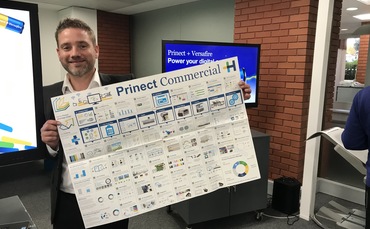Miles, who took over from Gerard Heanue as managing director of the UK operation earlier this year, said that the manufacturer had to adapt its business model in the face of predictions that 27,000 commercial printers worldwide would shrink to just 9,000.
Speaking at Heidelberg’s ‘power your digital output’ open house event, he said: “The days are gone when you can spend ten years developing a technology. We have to move quicker and get things out into the market. We can’t wait and be late adopters.
“The technology jump since 2011/12 has been incredibly fast. You have to be bold in business when technology is taking over,” he stated, citing Heidelberg’s ‘Push to Stop’ technology as an example.
The challenges facing the UK business are evident in its most recent results, for the year to 31 March. Sales fell by 14.5% to just under £79m due to “difficult trading conditions in the printing industry and Brexit”.
And although gross margins actually increased slightly, a £2m hit because of the requirement to equalise pension benefits between men and women and a £2.15m increase in other pension costs propelled the business to an operating loss of nearly £2.5m (2018 operating profit: £2.6m).
“With the number of commercial printers predicted to fall to 9,000 over the next ten years we as a company have to change. People are taking two presses out and putting one in, so we have to find other ways to add value,” Miles added.
He said recent personnel changes, including the departure of sales director Jim Todd and upcoming departure of main board member Stephan Plenz, were “part of the same strategy across the group”.
“We’ve got to bring in new thinking and that’s positive and good for us. Our customer-facing people have to have a new approach.”
At the open house Heidelberg showed how Prinect Production Manager could intelligently route jobs to digital or litho production depending on which output device offered the best option – rather than having a “separate island of digital production”.
The software options in Prinect have been simplified and it is now available with a modular subscription-style pricing model starting at a low monthly fee. Jacob Hededam Hummel (pictured below), Heidelberg head of software sales and service in Northern Europe, said this had removed the previous barrier to entry for some customers.

“When people say workflow they think about pre-press, but it’s not just pre-press it’s your entire business. Customers can unlock extra capacity with an integrated workflow,” he said.
“We’ve now got access to smaller customers because of the subs model, and we have already gained 500 new customers worldwide because of this. Customers can start small with Prinect and then use more software as they grow.”
Miles said he had been pleased with the attendance at the event. “We had quality people here who came with a purpose,” he said.
“What I like about the UK market is that it’s not just about massive web-to-print volumes. There are other niche players doing very well and to me that’s very encouraging.”








